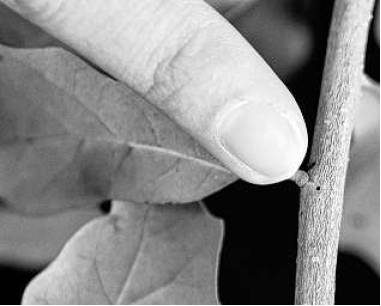Rice student creates buzz with discovery
Newly found wasp named after university watering hole
By Andrea Leinfelder STAFF WRITER
There’s a swarm of undiscovered insects living outside of Rice University’s graduate student pub.
Tiny wasps like to lay eggs in the live oak trees that line campus. And as students study this ecosystem — the trees, the wasps and the bugs that eat the wasps — they often stumble across new insect species.
That’s what happened to graduate student Pedro Brandão-Dias. He chose to name the new wasp after the Valhalla pub since that’s where this particular tree was located.
“It would have been a missed opportunity to not call it something related to Rice or Valhalla,” he said in a news release.
This wasp, Neuroterus (noo-ROH’-teh-rus) valhalla, is not a murder hornet coming to invade Houston. It’s just 1 millimeter long and does not sting humans.
But it’s a great example of how little humans know about the insect world. The N. valhalla wasp was described in a paper published this month in the journal Systematic Entomology.
“We do not need to worry about these gall wasps,” Scott Egan, who runs an evolutionary biology lab at Rice, said in an interview with the Houston Chronicle. “I am worried about all of this unknown, undescribed biodiversity sitting outside the front door of the biology building at Rice.”
Ega was Brandão’s professor in 2018 when Brandão discovered the N. valhalla wasp. It took several more years, a serendipitous discovery in Florida and assistance from researchers at the University of Iowa to confirm this was a new species.
N. valhalla is a type of cynipid gall wasp. These wasps are unique because they trick their host trees into feeding and sheltering their young. When the wasps lay eggs, they release a biochemical cocktail that coaxes the tree to form a crypt, or gall, around the egg. This provides shelter and food until the wasp hatches.
This family of wasps lays eggs twice a year in different parts of the tree, which is why they can be difficult to find.
N. valhalla wasps emerge from their galls in the spring just as the live oak tree’s flowers, called catkins, begin to form. The wasps have a few days to lay eggs before they die.
They lay eggs in the tree’s flowers, so their offspring have about two to three weeks to mature and hatch before the flower falls to the ground.
But then the cycle changes. This group that hatches before the flowers die lay eggs in a node where two tree stems split off. These eggs live here for 11 months, and the wasps emerge in time for the tree to flower the following spring.
Brandão found the N. valhalla in the spring of 2018 when looking at live oak flowers for another species. The N. valhalla were smaller and had lighter colored legs. He noted the data but couldn’t declare it a new insect until he learned when and where the next batch of eggs would hatch.
“It didn’t match up with anything we’d seen before,” Egan said. “That happens to us literally every single year.”
This is where the serendipity comes in. Another Rice professor, Kelly Weinersmith, was studying a gall wasp and one of its parasites in live oak trees in Florida. She sent samples from tree nodes to collaborators at the University of Iowa, who were looking for something entirely different, and those researchers didn’t recognize the species. So they sent the data to Egan’s lab for additional testing.
Brandão, who had continued his own testing in Houston, was able to confirm that it was the same species.
There are roughly 1,000 different gall wasp species, and about 15 of them (including N. valhalla) can be found on Gulf Coast live oaks, including Rice University’s campus, Egan said.
This was the first new gall wasp species to be discovered by Egan or his students. They typically discover parasitic insects that live inside the gall with the wasp and either eat the wasp or the gall itself. One species that Egan bagged while on a family vacation in Florida actually needs the wasp’s assistance to escape the gall. It somehow persuades the wasp to open a hole and stick out its head — then the parasitic insect eats its way through the wasp’s body and emerges from its head.
Now that N. valhalla has been discovered, Rice undergraduate student Camila Vinson is taking its study one step further. She’s looking into whether this tiny wasp was affected by last year’s freeze.
That question could be answered this year if the trees’ flowers emerge on time and the tiny wasps’ eggs are found among the flowers. andrea.leinfelder@chron.com


